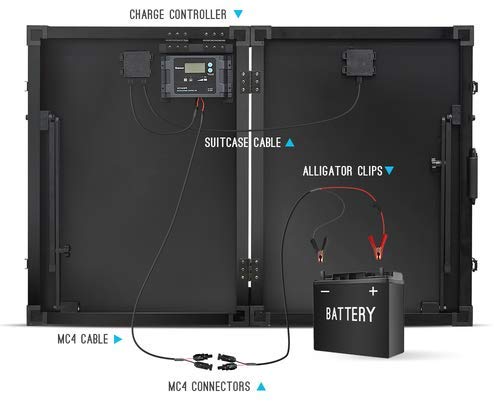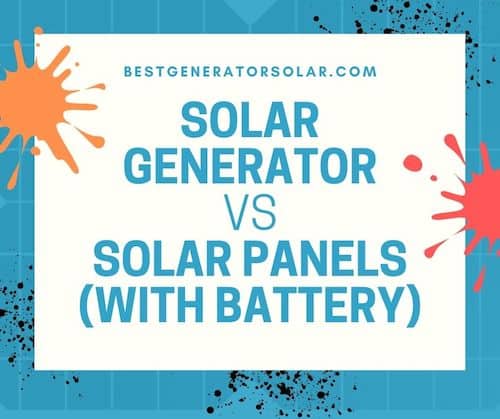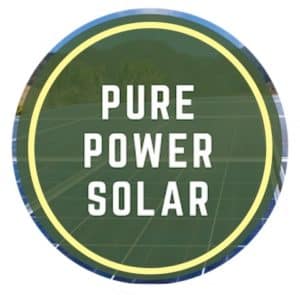As the world tries to get away from nonrenewable energy sources and find energy in more innovative ways, solar power generation has become one of the most popular alternatives in the industry today.
Whether you are looking to provide enough energy to power your home or business, or if you’re just looking for a portable power source to take with you anywhere you go, solar generation might be the best option for you.
So what’s the best way to harness the power of the sun and create a renewable energy source?
This article will dive into a comparison between using solar generators or using solar panels with batteries to help you better understand what the best option is for you and your power needs.
Solar generators are generally better than custom solar panels and battery setups because there is less preparation and installation work involved. A solar generator already has all of the necessary components within its system.
At this point, you’re probably curious as to how solar power generation works, so let’s start there.
Read on to learn everything you need to know about solar generators vs solar panels (with batteries).
What’s Needed for Solar Power Generation?
Before getting into the gritty details of the two types of solar generation being discussed in this article, it’s important to know the components necessary to produce power from the sun.
Since the goal of solar generation is to harness the energy from the sun and convert it into a usable power supply, certain parts and pieces are needed.
You can’t simply plug something into the sunlight and turn it on — but how great would that be?
To capture and convert the energy from the sun into usable power, there are four main components needed regardless of which type of solar generation you go with.

These four components include solar panels, a charge controller, solar batteries, and an inverter. Breaking solar generation down into these necessary components makes the process much easier to understand, so let’s take a look at how each of these works to better understand solar generation as a whole.
Solar Panels
Undoubtedly the most recognized piece of the solar generation puzzle, solar panels are of course an integral part of the process. These panels are what enable the energy from the sun to be captured and converted into electricity.
As the sunlight passes through the photovoltaic cells of the solar panels, electrons are excited and a flow of electricity is formed.
The technical details of how solar panels work could be an article all on its own, but the above is a basic lesson on what solar panels do with the sunlight that hits them.
The issue with the electricity that they produce is that it is direct current (DC), and you’ll be looking for alternating current (AC) as a power source. That’s where the rest of the process comes into play.
Charge Controller
The next stop in the solar power generation process is the charge controller. The purpose of the charge controller is two-fold.
First and foremost, it needs to convert the electricity that was produced by the solar panels to the voltage required to charge the batteries.
Secondly, the charge controller must regulate the power flowing from the solar panels to the batteries to prevent damage from occurring to the batteries.
Without the charge controller — sometimes referred to as the battery charger — the solar batteries would not be able to charge at all.
You’d be left with an array of solar panels producing electricity that does nothing for you.
The charge controller is an important part of the process that is probably the most forgotten.
Batteries
Once the charge controller has done its magic converting and regulating the power coming from the solar panels, the batteries can start being charged. Batteries are used to store solar energy for later use when you need it.
The bigger the battery capacity, the longer you can power your devices with its stored energy.
Since solar power requires the sun to be present, it is not always possible to generate power any time you need it, so having solar batteries store this power for you will come in handy whenever you need power.
Inverter
The final step of the solar generation process is inverting that power into a usable source of energy. This is accomplished by using, you guessed it, an inverter.
As mentioned previously, the energy generated from solar panels is produced as DC power. The issue with this is that pretty much anything that you would want to plug into the power source requires AC electricity — thus the need to invert the power.
Like the charge controller, the inverter has two main jobs that it must accomplish. The first is of course to invert the power from DC to AC using sine wave inverters.
Now that the electricity is in the correct form that can be used, the voltage must be stepped up to a usable amount. The solar batteries will typically be 12V or 24V (maybe even 48V), but you need 110V or 220V for most of the appliances you’ll be using.
So the inverter will also ramp the voltage up to that number and voila! This power will run to an outlet and you can start using your solar power!
Similar: What Can a Solar Generator Power? (Charging, Capacity, and More)
Solar Generators — The All-In-One Power Source
This all-in-one power source, known simply as solar generators, has been taking the solar market by storm due to its convenience and portability.
Maybe you like to go camping or maybe you just like to do some work out in the yard and don’t want to feed extension cords everywhere you go. For either of these cases and a slew of other potential uses, a solar generator is perfect for you.
Solar generators work by harnessing the energy from the sun and converting that energy into usable power wherever you are.
Taking the four components you learned about above and packing them together into one easy to use machine, solar generators offer the unique ability to have a source of power anywhere you go — as long as the sun is shining!
With inputs for the solar panels and outputs for all sorts of appliances, solar generators make having power possible anywhere that there’s sunlight.
You’ll be able to operate power tools, cook your food, or make a cup of coffee anywhere in the world.
Making them even easier to use, most solar generators have LCD screens that are easy to read and will help you keep track of how much longer it needs to charge the batteries, how much power it’s producing, battery levels remaining, and more.
They are truly an all-in-one solution to power generation and it’s no wonder why they’ve been gaining more and more popularity.
Pros:
- All-in-one solution that provides you with a source of power anywhere you go as long as the sun shines there.
- Little to no DIY work is required for setting it up. You can usually just get it out of the box (or take it off the shipping crate depending on its size) and start using it as soon as possible.
- Comes built with the right charge controller and inverter to provide the power you need. No need to work on figuring out which ones are necessary and buying any extra components.
- The LCD screen makes it easy to see the power level, how much juice is left in the batteries, how long until they’re charged, and more.
Cons:
- Expensive to buy for the power levels that they provide.
- Typical power output ranges from 0.1 – 3.0 kWh.
- Can usually only power some small appliances throughout the day, or maybe something a bit bigger for a shorter amount of time.
Similar: Top 15 Best Solar Generators for Camping (Small to Large)
Solar Panels With Batteries — Great for Custom Fitting

Solar panels with batteries are exactly what it sounds like — you use solar panels to charge batteries and provide power for yourself.
With this method of solar generation, you are doing pretty much the same process that happens within a solar generator.
Solar panels with batteries, however, are not limited to the size and configuration of the machine itself so they can be custom-fit to the user’s needs much more easily.
Perfect for adding power to your home, RV, shed, etc., solar panels with batteries can be customized to fit your needs and the structure that you’re adding them to.
These are the typical setups that people think when they think of solar power generation — solar panels fixed to the roof of a house or building or created in an array out in the middle of a field somewhere.
Whereas solar generators are easy to set up and use right out of the box, solar panels will require a bit more DIY work to get them to fit whatever you’re using them for, but the setup can be much more fine-tuned to provide exactly what you need.
This is more of a fixed solution that requires a little more effort up front, but once it’s up and running you’ll have the perfect system designed exactly for your needs.
Don’t let the name fool you, as you don’t only need solar panels and batteries. Just like the solar generators, you’ll also need a properly spec’d charge converter and inverter before you can have a fully functioning, safe to use power source.
Pros:
- Using batteries with solar panels can work with your home
 , business, RV, boat, shed, or anything that you want to provide power for.
, business, RV, boat, shed, or anything that you want to provide power for. - Ability to provide massive amounts of power — enough to even power a home or business
- They can be fine-tuned for exactly what you need from panel shapes to power output.
Cons:
- More work upfront to get everything working together effectively.
- Incredibly expensive as you start going bigger and bigger.
- If you’re doing any of it yourself you need to be sure to get the correct charge controller and inverter for safe and functional use.
Key Differences Between Solar Generators and Solar Panels With Batteries

By now you should have a better idea of what solar power generation is as a whole and two of the most common approaches to harnessing the power of the sun.
As you likely noticed while reading more about each method, there are some key differences between the two. Let’s take a look at some of the most important differences so that you can decide which method suits you and your needs best.
Setting the Systems Up
One of the biggest differences between using a solar generator or using solar panels with batteries is the process of setting them up.
Even though the actual process of converting energy from the sun into a source of power is largely the same between the two, getting them to do that requires quite a different amount of work on your end.
With a solar generator, you will buy the whole unit already assembled and ready to go. You might need to install a few features here and there like a handle or set of wheels when applicable, but that’s about it.
The panels, charge controller, batteries, and inverter are already working together and you can rest assured knowing that the proper charge controller and inverter are installed for the solar panels and batteries being used.
You can pretty much just set it up in the sunlight and voila, you can start to generate power.
If you’re using solar panels with batteries, more work is required to get everything set up when you decide to begin the project.
Since you can customize the solar panel placement while installing them, it is the perfect option for adding power to your home, shed, or RV.
Getting the panels sized correctly, the proper charge controller, and necessary inverter will require a bit more research and effort, but the final product will be customized to fit your needs exactly and can provide much more power than a solar generator if need be.
Similar: Inergy Apex vs EcoFlow Delta 1300 – Which is the Superior Solar Generator?
Power Output
If you are thinking about going with solar power generation, there must be a reason.
There needs to be something or somewhere that you’re hoping to provide power for, so knowing the power output that each of your potential options may provide is important.
Starting with solar generators, you don’t get nearly as much energy storage capacity as you might be thinking.
By looking at the solar generators available on the market today, you will see the vast majority of them have the capacity to store 0.1 – 3.0 kWh worth of energy.
Without going into too much detail on what Kilowatt-hours (kWh) are, just know that it’s estimated that the average home in the United States uses about 30 kWh of power per day.
of power per day.
This means that even if your generator is on the higher end of the spectrum with a storage capacity of 3.0 kWh, you would need ten of them to power your home.
This is of course unfeasible, but you don’t normally buy solar generators to power your home. Solar generators are instead the perfect option for powering smaller appliances as you need them throughout the day.
On a camping trip, working on the farm, whatever you’re doing outside, they should provide more than enough energy to power a few smaller things through the day or a couple of bigger things for a short time.
On the other hand, solar panels with batteries can be customized and designed to fit just about any application that you need.
If you want to add some solar panels to your shed to power a TV and minifridge as you turn it into a man cave, go for it. If you want to add a much bigger array to the roof of your house and power your entire residence, you can do that too.
With solar panels, you have much more flexibility to design a system that fits your needs and can provide you with the power you need.
Cost
Lastly, the big one — cost. While solar power generation is largely touted as paying for itself over time, there are still substantial upfront costs that need to be paid.
Whether you’re buying a solar generator or thinking about designing a custom solar panel array, it can be an expensive undertaking, to say the least.
Depending on brand, features, and power output, solar generators typically range in cost from around $500-$3,000+.
While this may seem cheap to some and expensive to others, keep in mind that you’ll typically be getting a generator that’s used to run smaller appliances or ~10% of your home’s total electrical use. So don’t think that for $1,000 you’ll have no electricity bills for the rest of your life!
When it comes to designing a custom array of solar panels with batteries, your price range will vary widely depending on the project.
If you’re adding solar panels to your RV, for example, you can expect to pay about $500-$2,000 — similar to the cost of a solar generator.
If you’re looking to add solar panels to your home with enough power output to live off of, you’re looking upwards of $50,000 – $75,000+ to produce 30 kWh.
Solar Generators or Solar Panels — Which is Better?

The answer to this question largely depends on what your goals for solar power generation are.
If you want to be able to go on on a cruise in your truck and power a few appliances when you pull over, then a solar generator might be best for you.
If your goal is to replace the entire electrical needs of your house using solar power, then a custom array of solar panels with batteries large enough to power your home is the best option.
Whenever you’re looking into solar power generation the main things you need to keep in mind are your goals, the power output that you’re looking to get, and what your budget is.
With those three things in mind, finding the perfect solar power generation setup for you should be a breeze!
Continue Reading:
Jackery Explorer 1000 Portable Power Station – Review and Analysis



